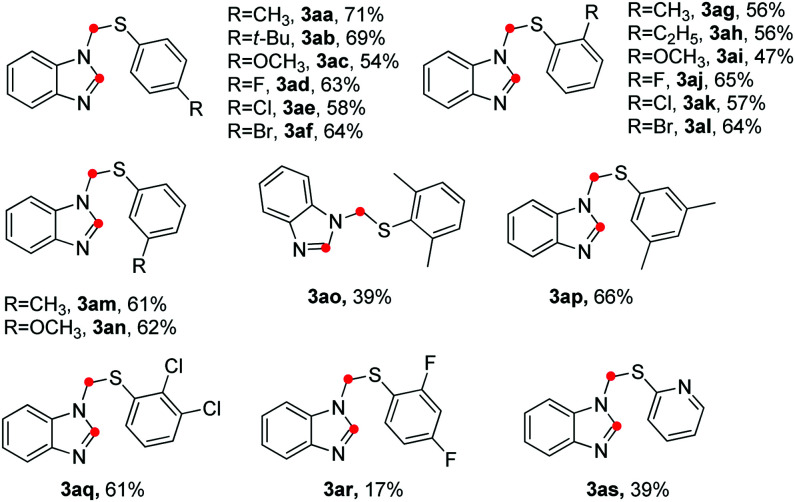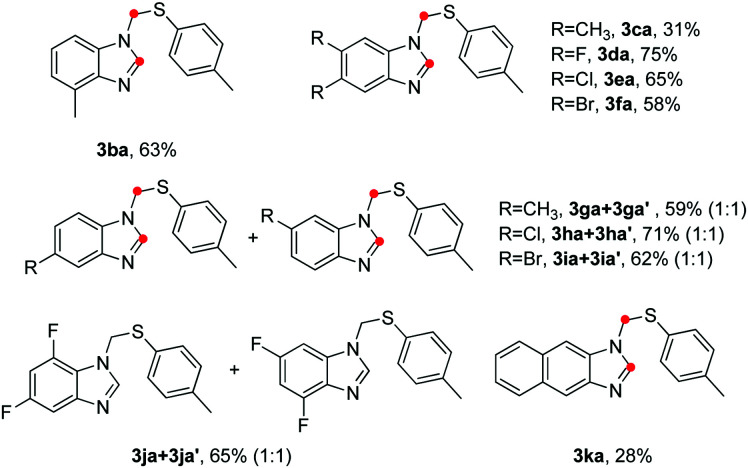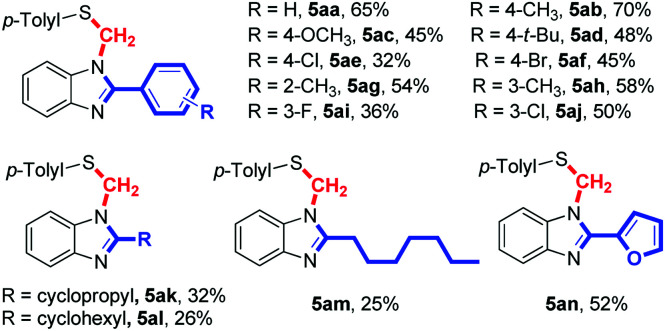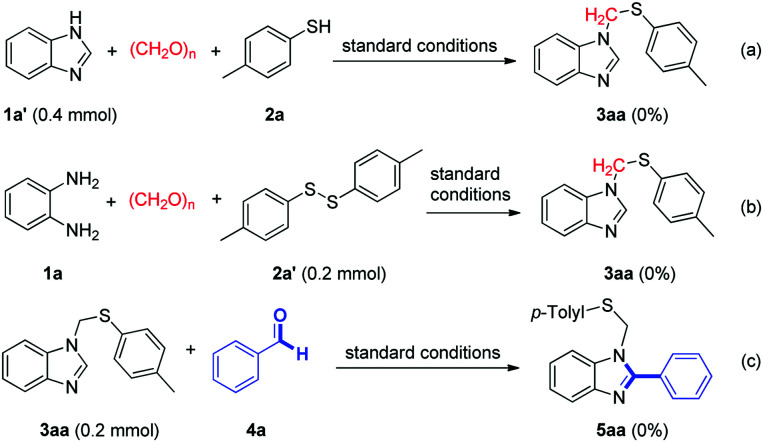Abstract
An efficient method for the synthesis of N-thiomethyl benzimidazoles from o-phenylenediamines, thiophenols, and aldehydes via C–N/C–S bond formation under metal-free conditions is described. A broad range of functional groups attached to the substrates were well tolerated in this reaction system. Stable and low-toxicity paraformaldehyde was used as the carbon source.
An efficient method for the synthesis of N-thiomethyl benzimidazoles from o-phenylenediamines, thiophenols, and aldehydes via C–N/C–S bond formation under metal-free conditions is described.
Benzimidazole and its derivatives are extremely important in pharmaceuticals and bioactive natural products because they have found applications in diverse therapeutic areas, such as anticancer agents, antimicrobials, antivirals, antifungals and so on.1 Furthermore, benzimidazoles are very important intermediates in organic synthesis and widely used as organocatalysts, ionic liquids and N-heterocyclic carbenes.2 In particular, the broad spectrum of biological activities of compounds with the 1,2-disubstituted benzimidazole moiety make them highly sought as synthetic targets.3 Therefore, several efficient protocols have been developed to synthesize substituted benzimidazoles over the past several decades.4 Three general methods for the construction of 1,2-disubstituted benzimidazole are as follows: (1) oxidative cyclocondensation,5 (2) C-1 or N-2 alkylation/arylation,6 and (3) inter/intramolecular N-arylation.7 To date, most of these methods are reported for 1-phenyl-2-benzyl benzimidazoles synthesis. However, few examples of multicomponent reactions led to the development of N-thiomethyl benzimidazoles from simple starting materials under mild conditions.8
Paraformaldehyde has been receiving more and more attention among molecule synthesis because of the advantages of low-cost, stability and low toxicity.9 It has been used as one-carbon homologation reagents for the synthesis of an incredible variety of complicated skeletons.10 In recent years, various methods have been developed to use paraformaldehyde to install a methylene,11 carbonyl12 and hydroxymethyl group13 into desired products. With respect to our recent studies on paraformaldehyde insertion to construct heterocycles, we reported synthetic methods for phthalazinones, 2-aroylbenzofurans and quinazolines formation.14 Very recently, we reported on an ethylenediamine-promoted three-component synthesis of 3-(thiomethyl)indoles from indoles, thiophenols, and paraformaldehyde.15 As part of our continuing efforts on using paraformaldehyde as the carbon source, herein, we describe a new and efficient multicomponent reaction for N-thiomethyl benzimidazoles formation from readily available starting materials. The reaction is successfully achieved in one-pot fashion under simple and facile reaction conditions (Scheme 1).
Scheme 1. New strategy for the synthesis of N-thiomethyl benzimidazoles.
For the optimization of reaction conditions, o-phenylenediamine (1a), p-toluenethiol (2a) and paraformaldehyde were chosen as model substrates (Table 1). To our delight, the desired product 3aa was obtained in 38% yield when the reaction was performed with K2CO3 in TCE/H2O (v/v = 7 : 2) at 130 °C for 3 h (entry 1). Afterwards, a variety of bases were investigated (Table 1, entries 2–8), and among them 4-ADPA (4-aminodiphenylamine) showed the best efficiency to give the corresponding product 3aa in 75% yield (Table 1, entry 8). As a control experiment, the desired product 3aa was obtained in 30% yield when the reaction was carried out in absence of 4-aminodiphenylamine (entry 9). The ratio of TCE/H2O slightly affected the reaction yield (entries 10–11). Other mixture solvents such as DMSO/H2O, anisole/H2O and PhCl/H2O were less effective for this kind of reaction (entries 12–14). Decreasing the reaction temperature or the amounts of 4-aminodiphenylamine all reduced the reaction yields (entries 15–16).
Optimization of the reaction conditionsa.

| |||
|---|---|---|---|
| Entry | Base | Solvent (v/v) | Yieldb (%) |
| 1 | K2CO3 | TCE : H2O = 7 : 2 | 38 |
| 2 | NaOH | TCE : H2O = 7 : 2 | 37 |
| 3 | KOtBu | TCE : H2O = 7 : 2 | 31 |
| 4 | Piperidine | TCE : H2O = 7 : 2 | 57 |
| 5 | DMAP | TCE : H2O = 7 : 2 | 40 |
| 6 | Morpholine | TCE : H2O = 7 : 2 | 35 |
| 7 | PDA | TCE : H2O = 7 : 2 | 58 |
| 8 | 4-ADPA | TCE : H2O = 7 : 2 | 75 |
| 9 | TCE : H2O = 7 : 2 | 30 | |
| 10 | 4-ADPA | TCE : H2O = 5 : 4 | 48 |
| 11 | 4-ADPA | TCE : H2O = 2 : 7 | 35 |
| 12 | 4-ADPA | DMSO : H2O = 7 : 2 | 22 |
| 13 | 4-ADPA | Anisole : H2O = 7 : 2 | 43 |
| 14 | 4-ADPA | PhCl : H2O = 7 : 2 | 29 |
| 15c | 4-ADPA | TCE : H2O = 7 : 2 | 61 |
| 16d | 4-ADPA | TCE : H2O = 7 : 2 | 52 |
Conditions: 1a (0.2 mmol), 2a (0.5 mmol), base (0.2 mmol), paraformaldehyde (0.8 mmol), solvent (0.9 mL), 130 °C, 3 h, air. PDA = 1,4-benzenediamine, 4-ADPA = 4-aminodiphenylamine, TCE = 1,1,1,2-tetrachloroethane.
GC yields.
110 °C.
4-ADPA (0.1 mmol).
With the optimized reaction conditions established, the scope of thiophenols was probed for the three-component reaction (Table 2). The model reaction of o-phenylenediamine (1a) with p-toluenethiol (2a) gave the desired product 3aa in 71% isolated yield. Other para-substituted thiophenols reacted with 1a to give N-thiomethyl benzoimidazoles (3ab–3af) in moderate to good yields. The position of the substituents on the benzene ring (ortho or meta) did not significantly affect the reaction yields (3ag–3an). A large range of functional groups attached to the benzene ring such as t-Bu (2b), methoxyl (2c) and halo (F, Cl, Br, 2d–2f) were well tolerated under the optimized reaction conditions. Notably, the C-halo bond cleavage of the substrates was not observed in the present base system. The reaction yields decreased dramatically when 2,6-dimethylbenzenethiol (2o) and 2,4-difluorobenzenethiol (2r) were used as the substrate. Modest yields were obtained when 3,5-dimethylbenzenethiol (2p) and 2,3-dichlorobenzenethiol (2q) were used as the substrates. To our delight, heteroaromatic thiols such as pyridine-2-thiol (2s) also participated in the reaction, albeit in low yield. Unfortunately, aliphatic thiols were much less effective coupling partners under the current reaction conditions.
Reaction of o-phenylenediamine with thiophenolsa.

|
|---|

|
Reaction conditions: 1a (0.2 mmol), 2 (0.5 mmol), 4-ADPA (0.2 mmol), paraformaldehyde (0.8 mmol), TCE (0.7 mL), H2O (0.2 mL), 130 °C, 3 h, air. Isolated yield based on 1a.
To further evaluate the scope and limitations of the reaction, various o-phenylenediamines were treated with p-toluenethiol (2a) and the results are presented in Table 3. When 3-methylbenzene-1,2-diamine (1b) was used as the substrate, the product 3ba was formed in 63% isolated yield with high levels of regioselectivity. Lower yield was obtained when 4,5-dimethylbenzene-1,2-diamine (1c) was used. Halogen substituents on the benzene ring, including F, Cl and Br, were compatible for this type of cyclocondensation (3da–3fa). As for non-symmetrical o-phenylenediamines (1g–1j), a mixture of two isomers (near 1 : 1 ratio) were obtained and difficult to be separated. In addition, the reaction of 2a with naphthalene-2,3-diamine 1k afforded the desired product 3ka in 28% yield.
Substrate scope with respect to the o-phenylenediaminea.

|
|---|

|
Reaction conditions: 1 (0.2 mmol), 2a (0.5 mmol), 4-ADPA (0.2 mmol), paraformaldehyde (0.8 mmol), TCE (0.7 mL), H2O (0.2 mL), 130 °C, 3 h, air. Isolated yield.
The reaction of o-phenylenediamine (1a), p-toluenethiol (2a) and paraformaldehyde with other different aldehydes was investigated (Table 4). We slightly modified the reaction conditions to find that the reactions could be smoothly performed at 100 °C. When benzaldehyde (4a) was used as the fourth component, the corresponding product 5aa was obtained in 65% yield. In general, other aromatic aldehyde derivatives bearing electron-donating groups such as CH3 or OCH3, or halogens such as Cl or Br on the aromatic ring all gave the desired products. The position of the substituent on the benzene ring (ortho or meta) affected slightly the reaction yields (5ag–5aj). In addition, aliphatic aldehydes such as cyclopropanecarbaldehyde (4k), cyclohexanecarbaldehyde (4l) and octanal (4m) were also suitable substrates for this kind of reaction, giving the corresponding products in moderate yields.
Reaction of o-phenylenediamine with aldehydesa.

|
|---|

|
Reaction conditions: 1a (0.2 mmol), 2a (0.5 mmol), 4 (0.4 mmol), 4-ADPA (0.2 mmol), paraformaldehyde (0.5 mmol), TCE (0.7 mL), H2O (0.2 mL), 100 °C, 3 h, air. Isolated yield.
We evaluated the late-stage transformation of 3aa (Scheme 2). When 3aa was treated with m-chlorope-roxybenzoic acid (m-CPBA) in CH2Cl2 at 50 °C, the oxidized sulfone product 6aa was obtained in 62% yield. The disulfonyl product 7aa and 8aa were obtained when p-toluenethiol (2a) or DMSO were used as the substrate with 3aa, although giving the corresponding products in lower yields.
Scheme 2. Application of present work. Reaction conditions: (a) 3aa (0.1 mmol), m-CPBA (0.2 mmol), CH2Cl2 (0.5 mL), 50 °C, 12 h; (b) 3aa (0.1 mmol), p-toluenethiol (0.2 mmol), AgNO3 (20 mol%), Cu(OAc)2 (0.2 mmol), DMF (1 mL), 120 °C, 12 h; (c) 3aa (0.1 mmol), AgNO3 (20 mol%), Cu(OAc)2 (0.2 mmol), DMSO (1 mL), 140 °C, 15 h.
To understand the mechanism of the reaction, we performed some control experiments under modified conditions. No desired product was observed when benzimidazole (1a′) was treated with p-toluenethiol (2a) and paraformaldehyde under standard conditions (Scheme 3a). No reaction occurred upon the treatment of o-phenylenediamine (1a) with 1,2-di-p-tolyldisulfane (2a′) and paraformaldehyde under the optimized reaction conditions (Scheme 3b). The reaction of 3aa with benzaldehyde (4a) could not give the corresponding product 5aa under standard conditions (Scheme 3c). According to above control experiments, a possible mechanism is illustrated in Scheme 4. Initially, condensation of o-phenylenediamine (1a) with formaldehyde generates an imine intermediate A. Then, intermediate A reacts with thiophenol anion to afford an intermediate B, which proceeds through intramolecular nucleophilic annulation to form intermediate C. Finally, dehydrogenative aromatization of intermediate C occurs to give desired product (3aa). On the other hand, the reaction mechanism of compound 5aa is similar to that of compound 3aa. Condensation of o-phenylenediamine (1a) with formaldehyde and benzaldehyde (4a) generates a non-symmetrical imine intermediate, which proceeds through nucleophilic addition/annulation/dehydrogenative aromatization sequence to give desired product (5aa).
Scheme 3. Control experiments.
Scheme 4. Proposed mechanism.
In summary, we have developed a simple and efficient method for the synthesis of N-thiomethyl benzoimidazoles from o-phenylenediamines, thiophenols, and aldehydes under metal-free conditions. In this system, three carbon–nitrogen bonds and one carbon–sulfur bond were formed with high levels of chemo-selectivity. Various functional groups were well tolerated under the optimized reaction conditions. This method affords an efficient and general approach for the synthesis of biologically important 1,2-disubstituted benzimidazole from readily available starting materials.
Conflicts of interest
There are no conflicts to declare.
Supplementary Material
Acknowledgments
Supported by the National Natural Science Foundation of China (21572194, 21502160, and 21871226), the Collaborative Innovation Center of New Chemical Technologies for Environmental Benignity and Efficient Resource Utilization.
Electronic supplementary information (ESI) available. See DOI: 10.1039/c9ra06144d
References
- (a) Bhattacharya S. Chaudhuri P. Curr. Med. Chem. 2008;15:1762. doi: 10.2174/092986708785133013. [DOI] [PubMed] [Google Scholar]; (b) Saxton J. E., Chemistry of Heterocyclic Compounds: Benzimidazoles and Cogeneric Tricyclic Compounds, Part 1, Wiley, Hoboken, 2008 [Google Scholar]; (c) Horton D. A. Bourne G. T. Smythe M. L. Chem. Rev. 2003;103:893. doi: 10.1021/cr020033s. [DOI] [PubMed] [Google Scholar]; (d) Vasiliou S. Drugs Today. 2011;47:647. doi: 10.1358/dot.2011.47.9.1688573. [DOI] [PubMed] [Google Scholar]; (e) Tamm I. Science. 1957;126:1235. [Google Scholar]; (f) Marqués-López E. and Herrera R. P., Multicomponent Reactions: Concepts and Applications for Design and Synthesis, Wiley, Hoboken, 2015 [Google Scholar]
- For selected recent examples see: ; (a) Lee M. Zhang L. Park Y. Park H. Tetrahedron. 2012;68:1452. doi: 10.1016/j.tet.2011.12.021. [DOI] [Google Scholar]; (b) Nájera C. Yus M. Tetrahedron Lett. 2015;56:2623. doi: 10.1016/j.tetlet.2015.03.099. [DOI] [Google Scholar]; (c) Ñíguez D. R. Guillena G. Alonso D. A. ACS Sustainable Chem. Eng. 2017;5:10649. doi: 10.1021/acssuschemeng.7b02613. [DOI] [Google Scholar]; (d) Mayank Billing B. K. Agnihotri P. K. Kaur N. Singh N. Jang D. O. ACS Sustainable Chem. Eng. 2018;6:3714. doi: 10.1021/acssuschemeng.7b04048. [DOI] [Google Scholar]; (e) Raimondi W. Bonne D. Rodriguez J. Angew. Chem., Int. Ed. 2012;51:40. doi: 10.1002/anie.201106741. [DOI] [PubMed] [Google Scholar]
- For selected examples see: ; (a) Seth K. Purohit P. Chakraborti A. K. Curr. Med. Chem. 2017;24:4638. doi: 10.2174/0929867323666161025142005. [DOI] [PubMed] [Google Scholar]; (b) Singla P. Luxami V. Paul K. RSC Adv. 2014;4:12422. doi: 10.1039/C3RA46304D. [DOI] [Google Scholar]; (c) Wang Z. Rizzo C. J. Org. Lett. 2001;3:565. doi: 10.1021/ol006968h. [DOI] [PubMed] [Google Scholar]; (d) Wang X. Bhatia P. A. Daanen J. F. Latsaw S. P. Rohde J. Kolasa T. Hakeem A. A. Matulenko M. A. Nakane M. Uchic M. E. Miller L. N. Chang R. Moreland R. B. Brioni J. D. Stewart A. O. Bioorg. Med. Chem. 2005;13:4667. doi: 10.1016/j.bmc.2005.04.060. [DOI] [PubMed] [Google Scholar]; (e) Windisch M. P. Jo S. Kim H. Y. Kim S. H. Kim K. Kong S. Jeong H. Ahn S. No Z. H wang J. Y. Eur. J. Med. Chem. 2014;78:35. doi: 10.1016/j.ejmech.2014.03.030. [DOI] [PubMed] [Google Scholar]
- For selected reviews see: ; (a) Largeron M. Nguyen K. M. H. Synthesis. 2018;50:241. doi: 10.1055/s-0036-1590915. [DOI] [Google Scholar]; (b) Rajasekhar S. Maiti B. Balamurali M. M. Chanda K. Curr. Org. Synth. 2017;14:40. doi: 10.2174/1570179413666160818151932. [DOI] [Google Scholar]; (c) Keiko N. A. Vchislo N. V. Asian J. Org. Chem. 2016;5:1169. doi: 10.1002/ajoc.201600227. [DOI] [Google Scholar]; (d) Carvalho L. C. R. Fernandes E. Marques M. M. B. Chem.–Eur. J. 2011;17:12544. doi: 10.1002/chem.201101508. [DOI] [PubMed] [Google Scholar]
- For selected recent examples see: ; (a) Sharma H. Kaur N. Singh N. Jang D. O. Green Chem. 2015;17:4263. doi: 10.1039/C5GC00536A. [DOI] [Google Scholar]; (b) Bahrami K. Khodaei M. M. Nejati A. Green Chem. 2010;12:1237. doi: 10.1039/C000047G. [DOI] [Google Scholar]; (c) Nguyen K. M. H. Largeron M. Eur. J. Org. Chem. 2016:1025. doi: 10.1002/ejoc.201501520. [DOI] [Google Scholar]; (d) Hikawa H. Ichinose R. Kikkawa S. Azumaya I. Asian J. Org. Chem. 2018;7:416. doi: 10.1002/ajoc.201700618. [DOI] [Google Scholar]
- (a) Lv R. Wang Y. Zhou C. Li L. Wang R. ChemCatChem. 2013;5:2978. doi: 10.1002/cctc.201300257. [DOI] [Google Scholar]; (b) Jeyachandran R. Potukuchi H. K. Ackermann L. Beilstein J. Org. Chem. 2012;8:1771. doi: 10.3762/bjoc.8.202. [DOI] [PMC free article] [PubMed] [Google Scholar]; (c) Sharma P. Rohilla S. Jain N. J. Org. Chem. 2015;80:4116. doi: 10.1021/acs.joc.5b00443. [DOI] [PubMed] [Google Scholar]; (d) Tran G. Confair D. Hesp K. D. Mascitti V. Ellman J. A. J. Org. Chem. 2017;82:9243. doi: 10.1021/acs.joc.7b01723. [DOI] [PMC free article] [PubMed] [Google Scholar]; (e) Turner G. L. Morris J. A. Greaney M. F. Angew. Chem., Int. Ed. 2007;46:7996. doi: 10.1002/anie.200702141. [DOI] [PubMed] [Google Scholar]; (f) Nguyen H. T. T. Doan D. N. A. Truong T. J. Mol. Catal. A: Chem. 2017;426:141. doi: 10.1016/j.molcata.2016.11.009. [DOI] [Google Scholar]; (g) Truong T. Nguyen V. T. Le H. T. X. Phan N. T. S. RSC Adv. 2014;4:52307. doi: 10.1039/C4RA09092F. [DOI] [Google Scholar]; (h) Zhang W. Tian Y. Zhao N. Wang Y. Li J. Wang Z. Tetrahedron. 2014;70:6120. doi: 10.1016/j.tet.2014.04.065. [DOI] [Google Scholar]
- For selected recent examples see: ; (a) Xie C. Han X. Gong J. Lia D. Ma C. Org. Biomol. Chem. 2017;15:5811. doi: 10.1039/C7OB00945C. [DOI] [PubMed] [Google Scholar]; (b) Zheng N. Anderson K. W. Huang X. Nguyen H. N. Buchwald S. L. Angew. Chem., Int. Ed. 2007;46:7509. doi: 10.1002/anie.200702542. [DOI] [PubMed] [Google Scholar]; (c) Zheng N. Buchwald S. L. Org. Lett. 2007;9:4749. doi: 10.1021/ol7020737. [DOI] [PubMed] [Google Scholar]; (d) Deldaele C. Evano G. ChemCatChem. 2016;8:1319. doi: 10.1002/cctc.201501375. [DOI] [Google Scholar]; (e) Hajipour A. R. Khorsandi Z. Mortazavicd M. Farrokhpour H. RSC Adv. 2015;5:107822. doi: 10.1039/C5RA22207A. [DOI] [Google Scholar]; (f) Gu Z. Liu Y. Wang F. Bao X. Wang S. Y. Ji S. J. ACS Catal. 2017;7:3893. doi: 10.1021/acscatal.7b00798. [DOI] [Google Scholar]; (g) Hajipour A. R. Khorsandi Z. New J. Chem. 2016;40:10474. doi: 10.1039/C6NJ02293F. [DOI] [Google Scholar]
- (a) Katritzky A. R. Ramer W. H. Lam J. N. J. Chem. Soc., Perkin Trans. 1. 1987:775. doi: 10.1039/P19870000775. [DOI] [Google Scholar]; (b) Rosen M. S. Stern C. L. Mirkin C. A. Chem. Sci. 2013;4:4193. doi: 10.1039/C3SC51557E. [DOI] [Google Scholar]
- For a review, see: ; Li W. F. Wu X. F. Adv. Synth. Catal. 2015;357:3393. doi: 10.1002/adsc.201500753. [DOI] [Google Scholar]
- Taylor R. T. and O'ullivan T. J., in Encyclopedia of Reagents for Organic Synthesis, John Wiley & Sons, Ltd, Chichester, 2001 [Google Scholar]
- (a) Li M. H. He C. Chen F. Gu Y. L. Adv. Synth. Catal. 2010;352:519. doi: 10.1002/adsc.200900770. [DOI] [Google Scholar]; (b) Park K. Heo Y. Lee S. Org. Lett. 2013;15:3322. doi: 10.1021/ol401358t. [DOI] [PubMed] [Google Scholar]; (c) Ohta Y. Kubota Y. Watabe T. Chiba H. Oishi S. Fujii N. Ohno H. J. Org. Chem. 2009;74:6299. doi: 10.1021/jo901090u. [DOI] [PubMed] [Google Scholar]; (d) Ohta Y. Chiba H. Oishi S. Fujii N. Ohno H. J. Org. Chem. 2009;74:7052. doi: 10.1021/jo901328q. [DOI] [PubMed] [Google Scholar]; (e) Natte K. Li W. Zhou S. Neumann H. Wu X. F. Tetrahedron Lett. 2015;56:1118. doi: 10.1016/j.tetlet.2015.01.099. [DOI] [Google Scholar]; (f) Mana N. Y. T. Lib W. Stewarta S. G. Wu X. F. Chimia. 2015;69:345. doi: 10.2533/chimia.2015.345. [DOI] [PubMed] [Google Scholar]
- (a) Garcia J. M. Jones G. O. Virwani K. Science. 2014;6185:732. doi: 10.1126/science.1251484. [DOI] [PubMed] [Google Scholar]; (b) Natte K. Dumrath A. Neumann H. Beller M. Angew. Chem., Int. Ed. 2014;53:10090. doi: 10.1002/anie.201404833. [DOI] [PubMed] [Google Scholar]; (c) Li W. F. Wu X. F. J. Org. Chem. 2014;79:10410. doi: 10.1021/jo5020118. [DOI] [PubMed] [Google Scholar]
- (a) Ngai M. Y. Skucas E. Krische M. J. Org. Lett. 2008;10:2705. doi: 10.1021/ol800836v. [DOI] [PMC free article] [PubMed] [Google Scholar]; (b) Okachi T. Fujimoto K. Onaka M. Org. Lett. 2002;4:1667. doi: 10.1021/ol025719l. [DOI] [PubMed] [Google Scholar]; (c) Köpfer K. Sam B. Breit B. Krische M. J. Chem. Sci. 2013;4:1876. doi: 10.1039/C3SC22051F. [DOI] [Google Scholar]; (d) Li W. Wu X. F. Eur. J. Org. Chem. 2015:331. doi: 10.1002/ejoc.201403359. [DOI] [Google Scholar]
- (a) Wang H. M. Cai J. H. Huang H. W. Deng G. J. Org. Lett. 2014;16:5324. doi: 10.1021/ol502498y. [DOI] [PubMed] [Google Scholar]; (b) Cheng F. Peng Y. Wu J. Deng G. J. Org. Biomol. Chem. 2016;14:2819. doi: 10.1039/C6OB00198J. [DOI] [PubMed] [Google Scholar]; (c) Cheng X. Wang H. Xiao X. F. Deng G. J. Green Chem. 2016;18:5773. doi: 10.1039/C6GC02319C. [DOI] [Google Scholar]
- Xiao F. Yuan S. Huang H. Deng G. J. Synlett. 2018;29:2693. doi: 10.1055/s-0037-1611023. [DOI] [Google Scholar]
Associated Data
This section collects any data citations, data availability statements, or supplementary materials included in this article.






